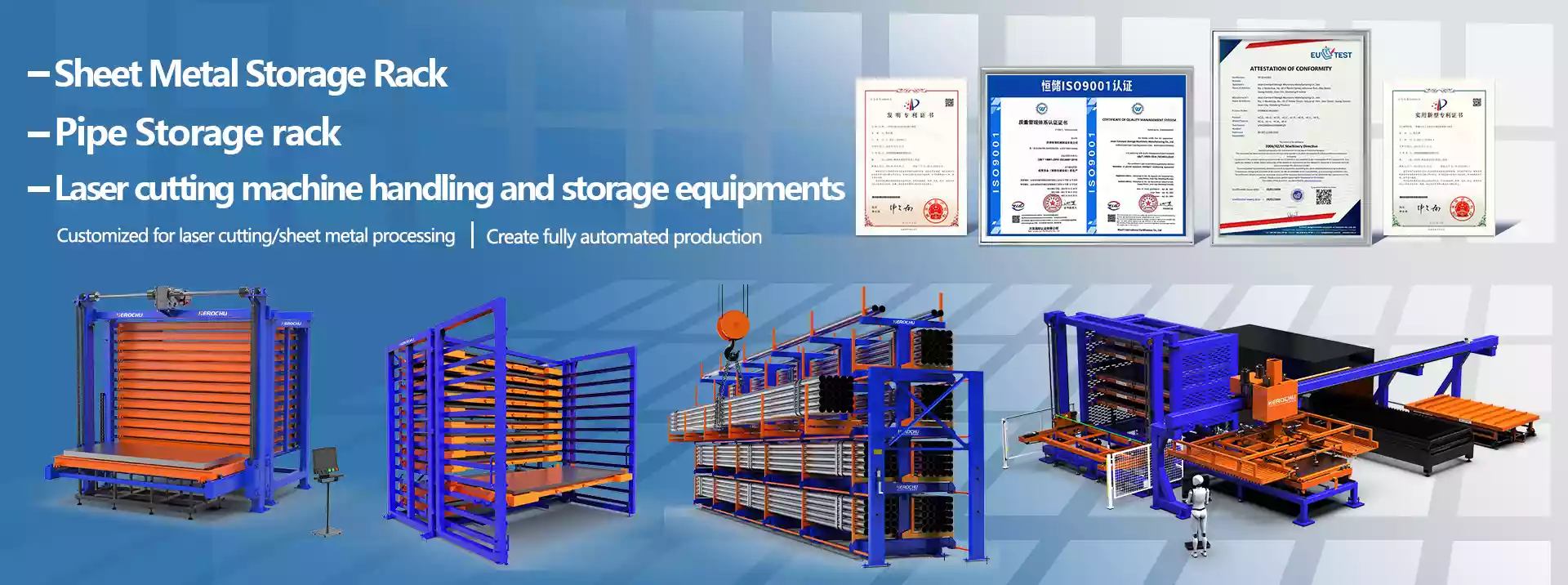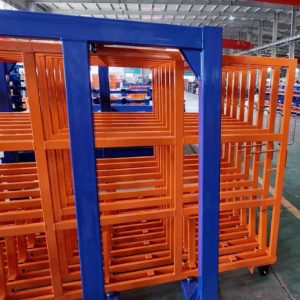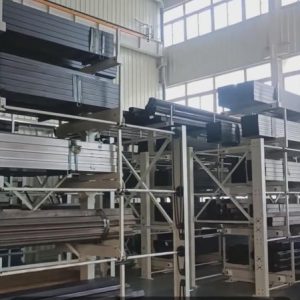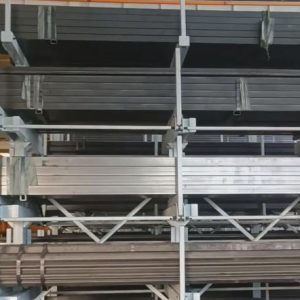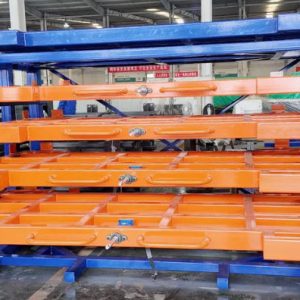For fabrication shop owners and warehouse managers, the word “safety” often gets tangled up with “expense.” It’s easy to see a sheet metal safety system as just another cost—something to check a compliance box rather than a strategic move. But here’s the hard truth: the real expense isn’t in investing in safety—it’s in ignoring it. A single workplace injury involving sheet metal can cost your business $100,000 or more in hidden and direct costs. Herochu’s CE, UE, and ISO 9001 certified Sheet Metal Warehouse Safety Systems change the equation. Starting at $4,399 and fully customizable to your workshop, this isn’t just a safety tool—it’s a profit-protecting asset that turns risk into resilience.
The Hidden Price Tag of a Sheet Metal Injury: Why “Cheap” Storage Costs You More
When a worker slips while moving a steel sheet, or a stack collapses onto a forklift operator, the first cost you see is a medical bill. But that’s just the tip of the iceberg. The true financial damage of an injury lurks in indirect costs—ones that can linger for months, even years, and cripple your bottom line. Let’s break down what a single serious incident really costs, so you can see why a “wise investment” in safety is non-negotiable.
Direct Costs: The Visible (But Small) Expense
Direct costs are the immediate, out-of-pocket bills that hit your accounts right after an accident. They’re stressful, but they’re nothing compared to what comes next:
- Medical Bills: Emergency room visits, surgeries, physical therapy, and follow-up care for a crushed hand or back strain can easily top $20,000. For severe injuries—like a sheet metal falling on a leg—costs can jump to $50,000 or more.
- Workers’ Compensation Payments: If an employee misses 3 months of work (a common timeline for a serious muscle strain or fracture), you’ll pay 66-2/3% of their wages. For a skilled operator making $30/hour, that’s over $14,000 in lost wage coverage.
- Insurance Premium Hikes: A single workers’ comp claim can raise your insurance rates by 20-50% for 3-5 years. If your annual premium is $15,000, that’s an extra $3,000-$7,500 per year—adding up to $22,500 over 5 years.
- Legal Fees: If the injury leads to a lawsuit (e.g., the employee claims you ignored safety hazards), legal defense costs can hit $10,000-$50,000, even if you win.
Add these up, and a single injury can cost $64,000-$182,500 in direct expenses alone. But the real killer is what you can’t see: indirect costs.
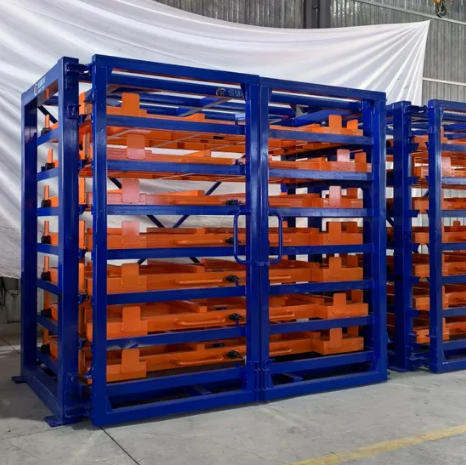
Indirect Costs: The Silent Profit Drain
Indirect costs are the operational and cultural damage that follow an injury—and they often triple or quadruple the total expense. For sheet metal warehouses, these costs hit where it hurts most: productivity and team trust.
- Lost Productivity: When an injury happens, work stops. The team members who rush to help can’t focus on their tasks. The time spent filling out OSHA reports, talking to insurance adjusters, and coordinating with doctors eats into hours that should be spent cutting, bending, or shipping metal. A 2023 study by the National Safety Council found that for every hour lost to an injury, businesses lose 3-5 hours of overall productivity. For a shop with 10 employees, that’s 30-50 hours of wasted time per incident—equivalent to $2,400-$4,000 in lost output (based on $20/hour average labor cost).
- Operational Shutdowns: A serious injury can trigger an OSHA inspection. If inspectors find safety violations (like unorganized floor stacks of sheet metal), they can shut down part of your facility until issues are fixed. A 1-week shutdown for a medium-sized shop can cost $50,000-$100,000 in lost orders and delayed deliveries.
- Retraining and Replacement: Skilled sheet metal operators are hard to find. If an injured worker can’t return for months, you’ll need to hire a temporary worker or train a new one. Training a new operator takes 4-8 weeks, during which time their output is 50-70% of a seasoned employee’s. That’s $8,000-$16,000 in lost productivity during training, plus $2,000-$5,000 in hiring fees.
- Damaged Morale: A workplace that feels dangerous kills team spirit. Employees start calling in sick more often, they work slower to avoid injury, and top talent leaves for safer shops. High turnover costs $3,000-$10,000 per employee (due to hiring, training, and lost productivity). Over a year, that can add up to $30,000-$100,000 for a 10-person team.
When you add indirect costs to direct costs, a single injury can cost your business $154,400-$453,500. That’s not just a cost—it’s a threat to your business’s survival. And traditional sheet metal storage systems make this threat inevitable.
Why Traditional Storage Is a Disaster Waiting to Happen
Floor stacking, generic shelving, or “make-shift” storage isn’t just disorganized—it’s a risk multiplier. Every day, your team is forced to perform high-risk tasks just to get their jobs done, turning routine material picks into games of chance. Here’s how traditional storage amplifies workers’ compensation risks:

The “Rummaging and Shuffling” Death Spiral
Imagine this: you need a 4×8-foot steel sheet from the bottom of a 3-ton stack. To get it, your team has to:
- Use a forklift to lift the top 2 tons of sheets and set them on the floor (risking a drop if the forklift operator misjudges the load).
- Have two workers manually pull the bottom sheet out (risking muscle strains or crushed fingers if the sheet shifts).
- Use the forklift again to put the top sheets back (risking a collision with the workers or the stack).
This isn’t a “procedure”—it’s an improvised, high-risk dance. Every step relies on perfect communication, perfect timing, and no mistakes. But mistakes happen: a forklift operator’s hand slips on the controls, a worker’s foot gets caught under a shifting sheet, or a stack tips over when the top layers are replaced. These aren’t “rare accidents”—they’re inevitable when your storage system forces people to work against physics.
The “Out of Sight, Out of Mind” Inventory Risk
Traditional storage also leads to hidden damage. When sheets are stacked haphazardly, they scratch, bend, or dent. A damaged sheet is either scrapped (costing $50-$200 per sheet) or has to be reworked (adding 1-2 hours of labor per sheet). But the bigger risk is inventory chaos: when you can’t see every sheet, you overorder (wasting money on excess stock) or underorder (delaying orders and losing customers). A single stockout of a critical sheet metal can cost $10,000-$20,000 in lost business—all because your storage system doesn’t let you track inventory easily.
Traditional storage isn’t a solution—it’s a problem that costs you money every day, in both small ways (scrapped sheets, wasted time) and big ways (injuries, shutdowns). Herochu’s Sheet Metal Warehouse Safety Systems fix this by engineering risk out of the equation.

Herochu’s Safety Systems: Engineering Risk Out, Profit In
A Herochu Sheet Metal Warehouse Safety System isn’t just a rack—it’s an “engineering control” (OSHA’s term for the most effective safety solution). Instead of asking your team to “be more careful,” we design the danger out of their workflow. Every feature is built to eliminate high-risk tasks, reduce strain, and turn chaos into control. Here’s how it protects your personnel and your profits:
1. Eliminates “Rummaging” with 100% Drawer Accessibility
Herochu’s systems use a drawer-based design—every sheet has its own dedicated drawer, no stacking required. To retrieve a sheet, a single operator extends the drawer (by hand-pull, hand-crank, or forklift) and accesses the material directly. There’s no lifting top layers, no coordinating with a forklift team, and no improvised moves. This one feature alone cuts the risk of crushing injuries and muscle strains by 90%, according to OSHA data on engineering controls.
For example, a small fabrication shop in Indiana switched from floor stacking to Herochu’s hand-crank system. Before, they had 2 near-miss incidents per month (a sheet slipping, a worker straining their back). After installation, they had zero incidents in 12 months. “We used to hold our breath every time someone needed a sheet from the bottom of the stack,” said the shop manager. “Now, it’s just a quick crank, and they’re done. No stress, no risk.”
2. Turns Heavy Lifting into Low-Effort Operation
The human body isn’t built to lift 3,000-pound sheets—but Herochu’s systems are. Our hand-crank models use a gear mechanism that lets one operator move 3-ton drawers with minimal effort (about the same force as turning a doorknob). For heavier loads (4.5+ tons), our forklift-ready drawers let operators handle the entire process from the safety of their cab—no manual lifting at all. This eliminates the #1 cause of workers’ compensation claims in sheet metal shops: muscle strains and sprains.
A mid-sized warehouse in Texas reported a 75% drop in strain-related injuries after installing Herochu’s forklift-ready system. “Before, we had two workers out with back injuries every quarter,” said the safety director. “Now, the forklift does the heavy work, and our team stays healthy. Our workers’ comp premiums dropped by 30% in the first year—more than covering the cost of the system.”

3. Customizable to Your Workshop’s Unique Risks
No two sheet metal warehouses are the same. You might store 2×4-foot aluminum sheets for automotive parts, while another shop stores 10×12-foot steel plates for construction. Herochu’s systems are fully customizable to your needs:
- Drawer Sizes: We build drawers to fit your exact sheet dimensions—no more forcing large sheets into too-small spaces or wasting room on oversized drawers.
- Load Capacities: Choose from 1.5-ton (hand-pull) to 10-ton (custom forklift-ready) capacities to match your materials.
- Layout: We design the system to fit your floor plan—whether you need a wall-mounted unit, a freestanding rack, or a modular setup that grows with your business.
This customization means your safety system doesn’t just “work”—it works for you. A custom fit eliminates awkward gaps, hard-to-reach drawers, and other hidden risks that generic systems miss.
4. Built to Last (and Protect) with Industrial-Grade Quality
Herochu’s systems are made from high-strength Q235 carbon steel—the same material used in bridges and industrial machinery. Every weld is precision-tested, every roller is sealed to prevent debris buildup, and every drawer is load-tested to 120% of its rated capacity. This durability means your system will protect your team for 10+ years—no rust, no bending, no unexpected failures.
Our CE, UE, and ISO 9001 certifications aren’t just logos—they’re proof that our systems meet the strictest global safety standards. When you invest in Herochu, you’re not buying a “cheap rack”—you’re buying a long-term safety partner.

The ROI of a Wise Investment: How Herochu Pays for Itself
Let’s do the math. A Herochu Sheet Metal Warehouse Safety System starts at $4,399. A single serious injury costs $154,400-$453,500. Even if our system prevents just one injury every 2-3 years, it’s already paid for itself. But the ROI doesn’t stop there—Herochu’s systems also save you money on productivity, scrap, and inventory.
Productivity Gains: More Work, Less Waste
With traditional storage, your team spends 2-3 hours per day “digging” for sheets. With Herochu’s system, that time drops to 30 minutes per day. For a 10-person team, that’s 17.5 extra hours of productive work per week—equivalent to adding 1 full-time employee without the extra salary. Over a year, that’s 910 extra hours of output—worth $18,200-$27,300 (based on $20-$30/hour labor costs).
Scrap Reduction: Keep Your Materials Valuable
Traditional stacking damages 5-10% of sheet metal (scratches, dents, bends). With Herochu’s system, scrap drops to less than 1%. For a shop that uses 1,000 sheets per year (average cost $100/sheet), that’s a savings of $4,000-$9,000 per year.
Inventory Control: No More Overordering or Stockouts
Herochu’s drawers let you see every sheet at a glance, so you know exactly what you have. This eliminates overordering (saving $5,000-$10,000 per year on excess stock) and stockouts (saving $10,000-$20,000 per year in lost business).
Add these up: $18,200-$27,300 (productivity) + $4,000-$9,000 (scrap) + $5,000-$10,000 (inventory) = $27,200-$46,300 in annual savings. That’s 6-10x the cost of a Herochu system (starting at $4,399) in the first year alone. This isn’t just an investment—it’s a profit center.
Why Herochu Is the Smart Choice for Safety (and Savings)
You could buy a generic safety rack, but generic systems cut corners—thin steel, untested welds, one-size-fits-all designs. They might save you money upfront, but they’ll cost you more in the long run (injuries, repairs, inefficiency). Herochu’s systems are different:
- Certified Safety: CE, UE, and ISO 9001 certifications mean our systems meet global safety standards—no shortcuts.
- Direct-from-Factory Pricing: As a source factory, we cut out middlemen, so you get industrial-grade quality at a small-business price (starting at $4,399).
- 24/7 Support: If you have a question or need a repair, our team is available around the clock. We don’t just sell you a system—we support you every step of the way.
- Proven Results: Our clients include small fabrication shops, large manufacturing plants, and everything in between. On average, they report a 60% drop in workplace incidents and a 25% increase in productivity within 6 months of installation.
Final Word: Safety Isn’t an Expense—It’s a Wise Investment
Every day you use traditional storage, you’re gambling with your team’s health and your business’s future. A single injury can derail your profits, damage your reputation, and even put you out of business. Herochu’s Sheet Metal Warehouse Safety Systems eliminate that gamble. They protect your personnel from harm, your profits from hidden costs, and your business from collapse.
Starting at $4,399 and fully customizable to your workshop, this isn’t just a safety purchase—it’s the smartest investment you’ll make all year. Because when you protect your team, you protect your bottom line.
Ready to stop gambling and start protecting? Contact Herochu today. Our team will visit your workshop (or do a virtual walkthrough), design a custom safety system that fits your needs and budget, and show you exactly how much you’ll save in injuries, scrap, and lost productivity. Your team deserves a safe workplace—and your business deserves the profits that come with it.
